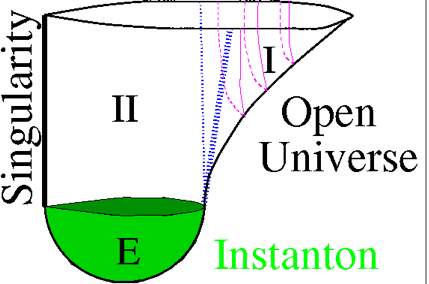General open inflation
The previous models for open inflation provide a counter-example to the standard lore on inflation, but they rely upon the presence of a local minimum in the potential energy of the inflation field. At our present level of understanding, we simply cannot tell whether this is what is predicted by a more fundamental theory such as M-theory or supergravity. But in the model theories for which we can calculate the inflation potential energy, such local minima do not usually appear.

Hawking-Turok Instanton. A bubble Universe emanates from a Hawking-Turok instanton. The verticle direction indicates time and the horizontal directions are spatial. E indicates the Euclidean region, where time becomes spacelike, and I is the bubble interior. The heavy line to the left indicates the mild singularity occurring in these solutions
Hawking and Turok realised that open inflation was in fact much more general, and could even occur in a theory where there is no local minimum in the inflaton potential energy. In fact, they showed that for essentially any potential energy function allowing inflation, an open Universe similar to that obtained in the expanding bubble described above could be formed.
Hawking and Turok's calculation was performed in the framework of a proposal for the initial conditions made in 1983 by Hawking and James Hartle. They proposed that the initial condition for the Universe should be that it possessed no initial boundary. One can picture the spacetime of an expanding Universe as the surface of a cone, placed vertically with its sharp tip down. Time runs up the cone: space runs around it. Time and space end at the sharp tip. The tip is 'singular' in mathematical terms and if this were a model of the Universe we would find all our equations break down there. Instead, Hartle and Hawking proposed that the tip be rounded off.
This rounding off is only possible if the nature of spacetime changes in the vicinity of the tip. In effect, all directions must become 'horizontal' near the tip, which is to say that all directions are spacelike. This is just what we need to explain how time began. In effect the distinction between space and time is blurred and space is then rounded off.
The region where time becomes spacelike is technically termed the instanton region. Instantons are solutions to the equations of general relativity and matter (here, the inflaton field) which have four spacelike directions. Hawking and Turok showed that for essentially any theory which allows inflation, there is a family of instanton solutions each one of which describes the formation of an inflating open Universe. The Hawking-Turok instantons do actually possess a singularity, but only at a single point. Unlike the singularity in the standard hot big bang, which is so severe that we cannot predict anything that happened in its presence, the singularity in the Hawking-Turok instantons is so mild that, as for the singularity in the electric field at the centre of a hydrogen atom, it does not affect our ability to make predictions.
The beauty of the instanton solutions is that they not only enable one to compute the probability of formation of open Universes from first principles, but one can also compute the spectrum of quantum fluctuations present in the open Universes, predicted by the no boundary proposal. Turok and DAMTP students Steven Gratton and Thomas Hertog have recently completed these calculations. The calculations have revealed a potential observational signature in the cosmic microwave sky that will, if the Universe has less than critical density, enable one to check which form of open inflation (i.e., with or without a local minimum of the potential) was actually involved.
